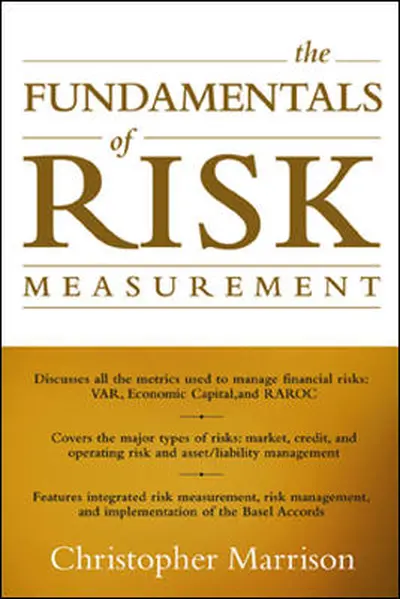My Account Details

ISBN10: 0071386270 | ISBN13: 9780071386272

Step 1 . Download Adobe Digital Editions to your PC or Mac desktop/laptop.
Step 2. Register and authorize your Adobe ID (optional). To access your eBook on multiple devices, first create an Adobe ID at account.adobe.com. Then, open Adobe Digital Editions, go to the Help menu, and select "Authorize Computer" to link your Adobe ID.
Step 3. Open Your eBook. Use Adobe Digital Editions to open the file. If the eBook doesn’t open, contact customer service for assistance.
A step-by-step guidebook for understanding—and implementing—integrated financial risk measurement and management The Fundamentals of Risk Measurement introduces the state-of-the-art tools and practices necessary for planning, executing, and maintaining risk management in today’s volatile financial environment. This comprehensive book provides description and analysis of topics including: Economic capital Risk adjusted return on capital (RAROC) Shareholder Value Added (SVA) Value at Risk (VaR) Asset/liability management (ALM) Credit risk for a single facility Credit risk for portfolios Operating risk Inter-risk diversification The Basel Committee Capital Accords The banking world is driven by risk. The Fundamentals of Risk Measurement shows you how to quantify that risk, outlining an integrated framework for risk measurement and management that is straightforward, practical for implementation, and based on the realities of today’s tumultuous global marketplace. “Banks make money in one of two ways: providing services to customers and taking risks. In this book, we address the business of making money by taking risk.…”—From the Introduction In The Fundamentals of Risk Measurement, financial industry veteran Chris Marrison examines what banks must do to succeed in the business of making money by taking risk. Encompassing the three primary areas of banking risk—market, credit, and operational—and doing so in a uniquely intuitive, step-by-step format, Marrison provides hands-on details on the primary tools for financial risk measurement and management, including: Plain-English evaluation of specific risk measurement tools and techniques Use of Value at Risk (VaR) for assessment of market risk for trading operations Asset/liability management (ALM) techniques, transfer pricing, and managing market and liquidity risk The many available methods for analyzing portfolios of credit risks Using RAROC to compare the risk-adjusted profitability of businesses and price transactions In addition, woven throughout The Fundamentals of Risk Measurement are principles underlying the regulatory capital requirements of the Basel Committee on Banking Supervision, and what banks must do to understand and implement them. The requirements are defined, implications of the New Capital Accord are presented, and the major steps that a bank must take to implement the New Accord are discussed. The resulting thumbnail sketch of the Basel Committee, and specifically the New Capital Accord, is valuable as both a ready reference and a foundation for further study of this important initiative. Risk is unavoidable in the financial industry. It can, however, be measured and managed to provide the greatest risk-adjusted return, and limit the negative impacts of risk to a bank’s shareholders as well as potential borrowers and lenders. The Fundamentals of Risk Management provides risk managers with an approach to risk-taking that is both informed and prudent, one that shows operations managers how to control risk exposures as it allows decision-making executives to direct resources to opportunities that are expected to create maximum return with minimum risk. The result is today’s most complete introduction to the business of risk, and a valuable reference for anyone from the floor trader to the officer in charge of overseeing the entire risk management operation.
Chapter 1: The Basics of Risk Management
Chapter 2: Risk Measurement at the Corporate Level: Economic Capital and RAROC
Chapter 3: Review of Statistics
MARKET RISK SECTION
Chapter 4: Background on Traded Instruments
Chapter 5: Market Risk Measurement
Chapter 6: The Three Common Approaches for Calculating Value at Risk
Chapter 7: Value at Risk Contribution
Chapter 8: Testing VaR Results to Ensure Proper Risk Measurement
Chapter 9: Calculating Capital for Market Risk
Chapter 10: Overcoming VaR Limitations
Chapter 11: The Management of Market Risk
ASSET/LIABILITY MANGEMENT SECTION
Chapter 12: Introduction to Asset Liability Management
Chapter 13: Measurement of Interest Rate Risk for ALM
Chapter 14: Funding Liquidity Risk in ALM
Chapter 15: Funds Transfer Pricing and the Management of ALM Risks
CREDIT RISK SECTION
Chapter 16: Introduction to Credit Risk
Chapter 17: Types of Credit Structure
Chapter 18: Risk Measurement for a Single Facility
Chapter 19: Estimating Parameter Values for Single Facilities
Chapter 20: Risk Measurement For A Credit Portfolio: Part One
Chapter 21: Risk Measurement For A Credit Portfolio: Part Two
Chapter 22: Risk Adjusted Performance and Pricing for Loans
Chapter 23: Regulatory Capital for Credit Risk
OPERATING RISK SECTION
Chapter 24: Operating risk
INTEGRATED RISK SECTION
Chapter 25: Inter-risk Diversification and Bank-Level RAROC
Need support? We're here to help - Get real-world support and resources every step of the way.